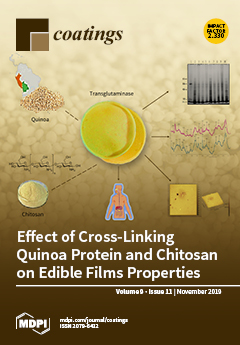Solid lubricant molybdenum disulfide (MoS
2) coatings have been frequently used to lubricate mechanisms operating in environments where oil and grease lubrication are ineffective. This work evaluated the rolling contact performance of a Titanium-containing MoS
2 coating under humid ambient, vacuum, and
[...] Read more.
Solid lubricant molybdenum disulfide (MoS
2) coatings have been frequently used to lubricate mechanisms operating in environments where oil and grease lubrication are ineffective. This work evaluated the rolling contact performance of a Titanium-containing MoS
2 coating under humid ambient, vacuum, and oil-lubricated conditions. Weibull analyses of L
50 lifetimes of AISI 52100 steel balls coated with a Ti-MoS
2 coating paired with uncoated M50 steel rods were determined to be 3.7, 14.5, and 158.6 million cycles in ambient, vacuum, and oil-lubricated environments, respectively. In the ambient and vacuum tests, failures were determined to be associated with the onset of abrasive wear rather than fatigue or spalling. The L
50 lifetimes of tests performed in those environments were found to depend upon the wear rate of the coatings on the balls. That is, the Ti-MoS
2 functioned as a barrier to the onset of abrasive wear between the steel alloys until the coating was sufficiently worn away. Under oil-lubricated (boundary lubrication) conditions, L
50 was found to depend on the durability and composition of tribofilms formed in-situ on the surfaces of the uncoated M50 rods. The tribofilms were comprised of mixtures of MoS
2 crystallites and amorphous hydrocarbon (a-C:H). The crystalline MoS
2 in the tribofilm originated from the amorphous Ti-MoS
2 coating and likely underwent a thermodynamic phase transition as a result of the applied Hertz stress and frictional heating in the contact. The a-C:H in the tribofilm probably originated from a catalytic scission of the polyalphaolefin (PAO) molecules caused by the d-band character of the Mo or Ti in the coating. Overall, the Ti-MoS
2-coated balls were effective at extending the operational lifetimes of M50 rods under ambient, vacuum, and oil-lubricated conditions by an order of magnitude.
Full article





